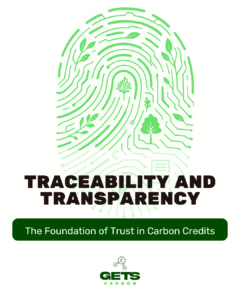The climate crisis is already impacting businesses across all sectors. With increasing regulatory pressures and more conscious consumers, reducing greenhouse gas emissions is no longer optional for companies – it has become a strategic requirement. In this context, organizations worldwide are seeking ways to cut their carbon footprint and achieve ambitious environmental goals. One of the most effective tools for this is offsetting emissions through carbon credits, which allows companies to neutralize residual CO₂ and directly contribute to slowing global warming.
What are carbon credits?
Carbon credits are certificates issued when a certain amount of greenhouse gases is reduced or removed from the atmosphere. By convention, each carbon credit corresponds to one metric ton of carbon dioxide (CO₂) equivalent that has either been prevented from being emitted or captured. In other words, it acts like a “green currency” backed by real emission reductions: by acquiring a credit, you are financing an environmental project that either avoided the emission of one ton of CO₂ (or an equivalent amount of another greenhouse gas) or removed that ton from the atmosphere.
These credits can be generated by different types of environmental projects. For example, renewable energy initiatives (solar, wind, biomass) avoid emissions that would occur if fossil fuels were used. Reforestation and forest conservation projects also generate credits, since trees and ecosystems capture and store large amounts of carbon that would otherwise be warming the planet. Other examples include energy efficiency programs, waste management, sustainable agriculture, and even direct air carbon capture. Since the Kyoto Protocol (1997) and the Paris Agreement (2015), a market has been created for these emission reductions – credits function as tradable certificates that countries, companies, or individuals can buy to offset their own emissions.
In short, by purchasing a certified carbon credit, your company is sponsoring climate action somewhere in the world and, in return, can neutralize one ton of its own emissions, accounting for this toward the net-zero goal. It is a way of “transferring the environmental cost” of emissions to those who can reduce or remove carbon more efficiently. Thus, polluters pay, and those who preserve or innovate gain an incentive, generating a positive cycle of sustainability investments.
Why are carbon credits important?
From a global perspective, carbon credits are a crucial tool for achieving the goals of the Paris Agreement. Atmospheric CO₂ concentrations have already surpassed pre-industrial levels by 151%, and experts warn that, at this pace, average global temperature could rise by more than 3 °C this century – far above the internationally agreed limit of 1.5–2 °C. To avoid this catastrophic scenario, global emissions must be reduced by about 42% by 2030. This requires a profound economic transformation. Directly reducing emissions (through energy efficiency, clean energy, etc.) is the priority, but it is not always possible to eliminate 100% of emissions immediately. This is where carbon credits come in: they allow companies to offset that percentage of emissions that are difficult to cut, ensuring progress toward net zero at the required speed.
For companies, investing in carbon credits brings several concrete benefits:
Meeting goals and compliance: Many organizations have already committed to becoming carbon neutral or net zero. Carbon credits make it possible to achieve these goals by offsetting the remaining emissions after reductions have been made. In addition, the use of certified credits helps meet current regulatory requirements and prepare for future environmental regulations. In Brazil, for example, a law enacted in 2024 created the Brazilian Emissions Trading System (SBCE), regulating the carbon market and establishing that large emitters will be required to reduce or offset CO₂. Becoming familiar with carbon credits now puts your company ahead in meeting these new rules.
Corporate image and competitive advantage: Consumers, investors, and business partners increasingly value companies committed to sustainability. By neutralizing your emissions and acquiring credits from recognized sources, your company gains international credibility and strengthens its reputation as responsible and innovative. Major global brands are already doing this – from the financial industry to events. To cite recent cases, companies like AstraZeneca, Netflix, Accenture, Heineken, among others, have neutralized 100% of emissions from corporate events and campaigns by calculating their carbon footprint and offsetting it with internationally recognized credits. This demonstrates a concrete commitment to climate action and sets the brand apart in the market. Clients and investors see these actions as a differentiator, which can translate into greater loyalty, preference, and even the attraction of new business.
Climate responsibility and internal engagement: Investing in carbon credits also engages employees and leadership around a common cause. Communicating that your company is carbon neutral inspires internal pride and encourages staff involvement in other green initiatives. In addition, credit purchases often support socio-environmental projects with co-benefits, such as generating income in local communities, protecting biodiversity, and promoting environmental education. In other words, beyond mitigating emissions, your company contributes to broader positive impacts, aligning with the Sustainable Development Goals (SDGs) and strengthening its ESG policy.
In summary, carbon credits allow your organization to take immediate responsibility for its emissions by offsetting what cannot yet be reduced. This enables short-term carbon neutrality goals while working toward long-term clean technologies. It is a win-win strategy: the climate benefits from reduced emissions, and your company gains in reputation, compliance, and even efficiency (since the offsetting process is often accompanied by improvements in carbon management).
If your company is looking to reduce CO₂ emissions and achieve environmental goals with security and credibility, rely on the expertise of Gets Carbon. Our team can assist you in every step – from emissions inventorying in line with recognized methodologies to the selection and acquisition of the best carbon credits in the voluntary or regulated market – ensuring that your offsetting is effective and delivers real results. Contact us and discover how to develop a tailor-made carbon neutralization project. Take the next step toward net zero and position yourself as a leader in sustainability. Join the green revolution and transform your emissions into value for your business!




